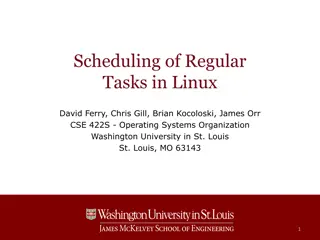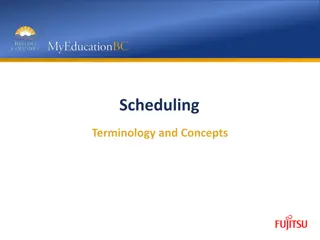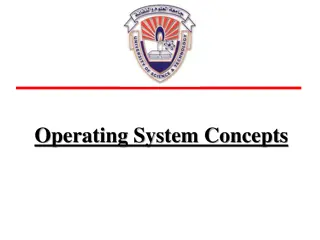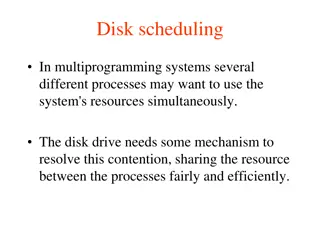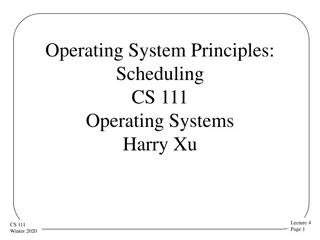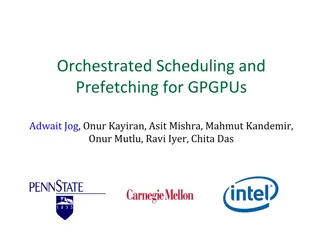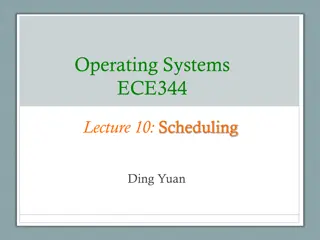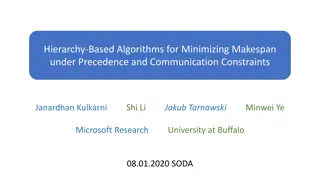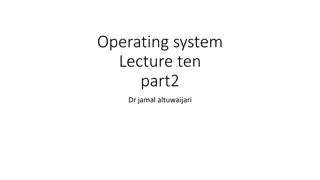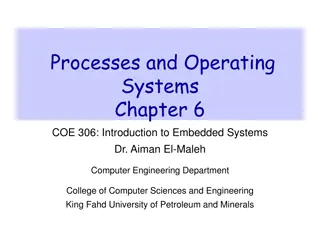Understanding Scheduling Algorithms in Operating Systems
Exploring the world of scheduling in operating systems, this content covers various aspects such as introduction to scheduling, process behavior, bursts of CPU usage, CPU-bound and I/O-bound processes, when to schedule processes, and the differences between non-preemptive and preemptive scheduling algorithms. Written by Ali Akbar Mohammadi, this resource provides insights into the key principles governing efficient task scheduling.
Download Presentation

Please find below an Image/Link to download the presentation.
The content on the website is provided AS IS for your information and personal use only. It may not be sold, licensed, or shared on other websites without obtaining consent from the author. Download presentation by click this link. If you encounter any issues during the download, it is possible that the publisher has removed the file from their server.
E N D
Presentation Transcript
Scheduling Scheduling Introduction to Scheduling Scheduling in Batch Systems Scheduling in Interactive Systems Scheduling in Real-Time Systems Policy versus Mechanism Thread Scheduling Ali Akbar Mohammadi 2
Introduction to Scheduling Introduction to Scheduling Process Behavior When to Schedule Categories of Scheduling Algorithms Scheduling Algorithm Goals Ali Akbar Mohammadi 3
Process Behavior Process Behavior Typically the CPU runs for a while without stopping, then a system call is made to read from a file or write to a file. When the system call completes, the CPU computes again until it needs more data or has to write more data, and so on. Note that some I/O activities count as computing. Ali Akbar Mohammadi 4
Bursts of CPU usage alternate with periods of Bursts of CPU usage alternate with periods of waiting for I/O. waiting for I/O. (a) A CPU-bound process. (b) An I/O-bound process. Ali Akbar Mohammadi 5
Computer Bound and I/O Bound Computer Bound and I/O Bound Computer Bound: processes that spend most of their time computing I/O Bound: Processes that spend most of their time waiting for I/O Ali Akbar Mohammadi 6
When to Schedule When to Schedule 1. When a process exits. 2. When a process blocks on I/O, or a semaphore. 3. When a new process is created. 4. When an I/O interrupt occurs. 5. When a clock interrupt occurs. Ali Akbar Mohammadi 7
Non Non- -Preemptive and Preemptive Scheduling Preemptive and Preemptive Scheduling A non-preemptive scheduling algorithm picks a process to run and then just lets it run until it blocks (either on I/O or waiting for another process) or until it voluntarily releases the CPU. A preemptive scheduling algorithm picks a process and lets it run for a maximum of some fixed time. If it is still running at the end of the time interval, it is suspended and the scheduler picks another process to run (if one is available). Ali Akbar Mohammadi 8
Categories of Scheduling Algorithms Categories of Scheduling Algorithms 1. Batch 2. Interactive 3. Real time Ali Akbar Mohammadi 9
Scheduling Algorithm Goals Scheduling Algorithm Goals In order to design a scheduling algorithm, it is necessary to have some idea of what a good algorithm should do. Some goals depend on the environment (batch, interactive, or real time), but there are also some that are desirable in all cases. Ali Akbar Mohammadi 10
Some goals of the scheduling algorithm under Some goals of the scheduling algorithm under different circumstances different circumstances All systems Fairness giving each process a fair share of the CPU Policy enforcement seeing that stated policy is carried out Balance keeping all parts of the system busy Batch systems Throughput maximize jobs per hour Turnaround time minimize time between submission and termination CPU utilization keep the CPU busy all the time Interactive systems Response time respond to requests quickly Proportionality meet users' expectations Real-time systems Meeting deadlines avoid losing data Predictability avoid quality degradation in multimedia systems Ali Akbar Mohammadi 11
Throughput, Turnaround Time Throughput, Turnaround Time, CPU Utilization CPU Utilization Throughput is the number of jobs per second that the system completes. Turnaround time is the average time from the moment that a batch job is submitted until the moment it is completed. It measures how long the average user has to wait for the output. CPU Utilization is keeping CPU as busy as possible, as the CPU is the major expense in computer. Ali Akbar Mohammadi 12
Scheduling in Batch Systems Scheduling in Batch Systems First-Come First-Served Shortest Job First Shortest Remaining Time Next Three-Level Scheduling Ali Akbar Mohammadi 13
First First- -Come First Come First- -Served Served Non-preemptive Single queue of ready processes easy to understand and equally easy to program Ali Akbar Mohammadi 14
Disadvantage Disadvantage Suppose that there is one compute-bound process that runs for 1 sec at a time and many I/O-bound processes that use little CPU time but each have to perform 1000 disk reads in order to complete. The compute-bound process runs for 1 sec, then it reads a disk block. All the I/O processes now run and start disk reads. When the compute-bound process gets its disk block, it runs for another 1 sec, followed by all the I/O-bound processes in quick succession. The net result is that each I/O-bound process gets to read 1 block per second and will take 1000 sec to finish. With a scheduling algorithm that preempted the compute-bound process every 10 msec, the I/O-bound processes would finish in 10 sec instead of 1000 sec, and without slowing down the compute-bound process very much. Ali Akbar Mohammadi 15
Shortest Job First Shortest Job First Non-preemptive Run times are known in advance Ali Akbar Mohammadi 16
Example Example Consider the case of four jobs, with run times of a, b, c, and d, respectively. The first job finishes at time a, the second finishes at time a + b, and so on. The mean turnaround time is (4 a + 3 b + 2 c + d) / 4. It is clear that a contributes more to the average than the other times, so it should be the shortest job, with b next, then c, and finally d as the longest as it affects only its own turnaround time. The same argument applies equally well to any number of jobs. Ali Akbar Mohammadi 17
Shortest Remaining Time Next Shortest Remaining Time Next A preemptive version of shortest job first is shortest remaining time next. With this algorithm, the scheduler always chooses the process whose remaining run time is the shortest. Again here, the run time has to be known in advance. When a new job arrives, its total time is compared to the current process' remaining time. If the new job needs less time to finish than the current process, the current process is suspended and the new job started. This scheme allows new short jobs to get good service. Ali Akbar Mohammadi 18
Three Three- -Level Scheduling Level Scheduling Ali Akbar Mohammadi 19
How to decide? How to decide? 1. How long has it been since the process was swapped in or out? 2. How much CPU time has the process had recently? 3. How big is the process? (Small ones do not get in the way.) 4. How important is the process? Ali Akbar Mohammadi 20
Scheduling in Interactive Systems Scheduling in Interactive Systems Round-Robin Scheduling Priority Scheduling Multiple Queues Shortest Process Next Guaranteed Scheduling Lottery Scheduling Fair-Share Scheduling Ali Akbar Mohammadi 21
Round Round- -Robin Scheduling Robin Scheduling Each process is assigned a time interval, called its quantum, which it is allowed to run. If the process is still running at the end of the quantum, the CPU is preempted and given to another process. If the process has blocked or finished before the quantum has elapsed, the CPU switching is done when the process blocks, of course. Round robin is easy to implement All processes importunacy assume equal. Ali Akbar Mohammadi 22
Round Round- -Robin Scheduling Robin Scheduling (a)The list of runnable processes. (b)The list of runnable processes after B uses up its quantum. Ali Akbar Mohammadi 23
How long the quantum should be? How long the quantum should be? If too short: Consider quantum 4 msec and Process switch( Context switch) will be 1 msec. 20% of CPU time is for switching. If too long: Consider quantum 100 msec and Process switch( Context switch) will be 1 msec. 1% of CPU time is for switching, but it is bad for time sharing. Best time is usually between 20 and 50 msec. Ali Akbar Mohammadi 24
Priority Scheduling Priority Scheduling Each process is assigned a priority, and the runnable process with the highest priority is allowed to run. To prevent high-priority processes from running indefinitely, the scheduler may decrease the priority of the currently running process at each clock tick. Ali Akbar Mohammadi 25
Dynamic Priority Dynamic Priority Priorities can also be assigned dynamically by the system to achieve certain system goals. For example, some processes are highly I/O bound and spend most of their time waiting for I/O to complete. Whenever such a process wants the CPU, it should be given the CPU immediately, to let it start its next I/O request, which can then proceed in parallel with another process actually computing. Ali Akbar Mohammadi 26
A scheduling algorithm with four priority classes A scheduling algorithm with four priority classes Ali Akbar Mohammadi 27
Multiple Queues Multiple Queues Each switch meant swapping the current process to disk and reading in a new one from disk. The designers quickly realized that it was more efficient to give CPU-bound processes a large quantum once in a while, rather than giving them small quanta frequently (to reduce swapping). On the other hand, giving all processes a large quantum would mean poor response time, as we have already observed. Their solution was to set up priority classes. Processes in the highest class were run for one quantum. Processes in the next highest class were run for two quanta. Processes in the next class were run for four quanta, and so on. Whenever a process used up all the quanta allocated to it, it was moved down one class. Ali Akbar Mohammadi 28
Example Example Consider a process that needed to compute continuously for 100 quanta. It would initially be given one quantum, then swapped out. Next time it would get two quanta before being swapped out. On succeeding runs it would get 4, 8, 16, 32, and 64 quanta, although it would have used only 37 of the final 64 quanta to complete its work. Only 7 swaps would be needed (including the initial load) instead of 100 with a pure round-robin algorithm. Furthermore, as the process sank deeper and deeper into the priority queues, it would be run less and less frequently, saving the CPU for short, interactive processes. Ali Akbar Mohammadi 29
Shortest Process Next Shortest Process Next Because shortest job first always produces the minimum average response time for batch systems, it would be nice if it could be used for interactive processes as well. To a certain extent, it can be. Interactive processes generally follow the pattern of wait for command, execute command, wait for command, execute command, and so on. If we regard the execution of each command as a separate "job," then we could minimize overall response time by running the shortest one first. The only problem is figuring out which of the currently runnable processes is the shortest one. Ali Akbar Mohammadi 30
Estimating the shortest runnable process Estimating the shortest runnable process Suppose that the estimated time per command for some terminal is T0. Now suppose its next run is measured to be T1. We could update our estimate by taking a weighted sum of these two numbers, that is, aT 0 + (1 a) T 1. Through the choice of a we can decide to have the estimation process forget old runs quickly, or remember them for a long time. Ali Akbar Mohammadi 31
Guaranteed Scheduling Guaranteed Scheduling A completely different approach to scheduling is to make real promises to the users about performance and then live up to them. One promise that is realistic to make and easy to live up to is this: If there are n users logged in while you are working, you will receive about 1 /n of the CPU power. Similarly, on a single-user system with n processes running, all things being equal, each one should get 1 /n of the CPU cycles. Ali Akbar Mohammadi 32
Lottery Scheduling Lottery Scheduling The basic idea is to give processes lottery tickets for various system resources, such as CPU time. Whenever a scheduling decision has to be made, a lottery ticket is chosen at random, and the process holding that ticket gets the resource. When applied to CPU scheduling, the system might hold a lottery 50 times a second, with each winner getting 20 msec of CPU time as a prize. Ali Akbar Mohammadi 33
Fair Fair- -Share Scheduling Share Scheduling So far we have assumed that each process is scheduled on its own, without regard to who its owner is. As a result, if user 1 starts up 9 processes and user 2 starts up 1 process, with round robin or equal priorities, user 1 will get 90% of the CPU and user 2 will get only 10% of it. To prevent this situation, some systems take into account who owns a process before scheduling it. In this model, each user is allocated some fraction of the CPU and the scheduler picks processes in such a way as to enforce it. Thus if two users have each been promised 50% of the CPU, they will each get that, no matter how many processes they have in existence. Ali Akbar Mohammadi 34


